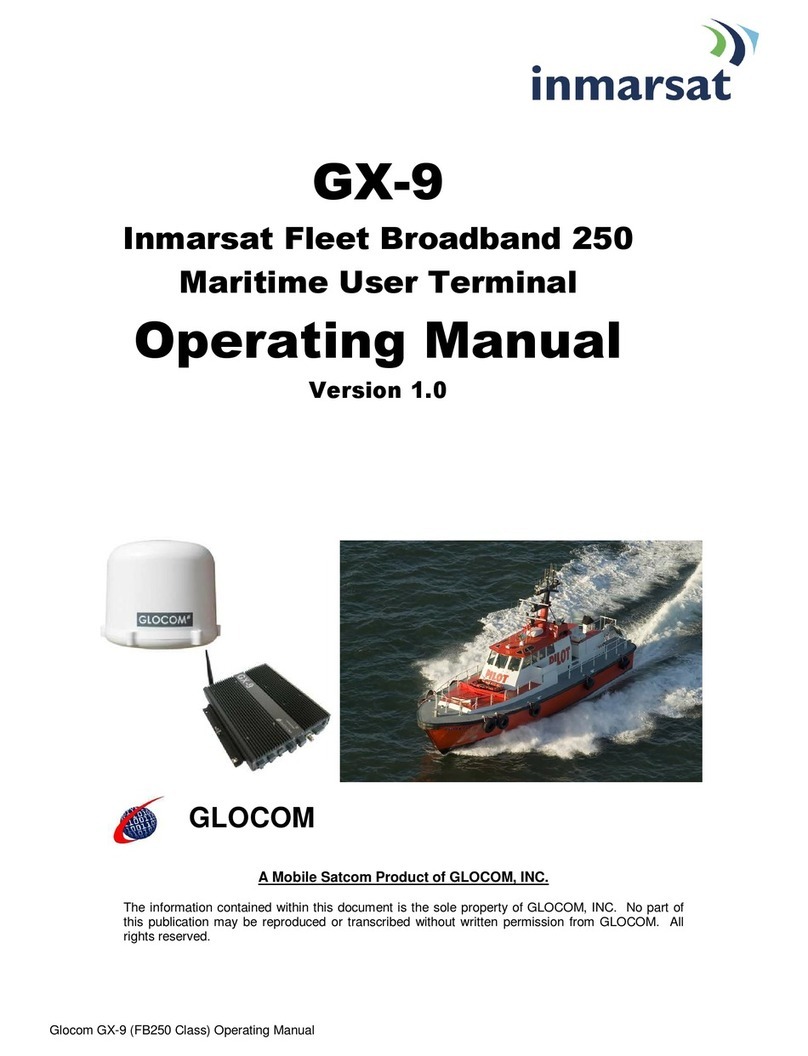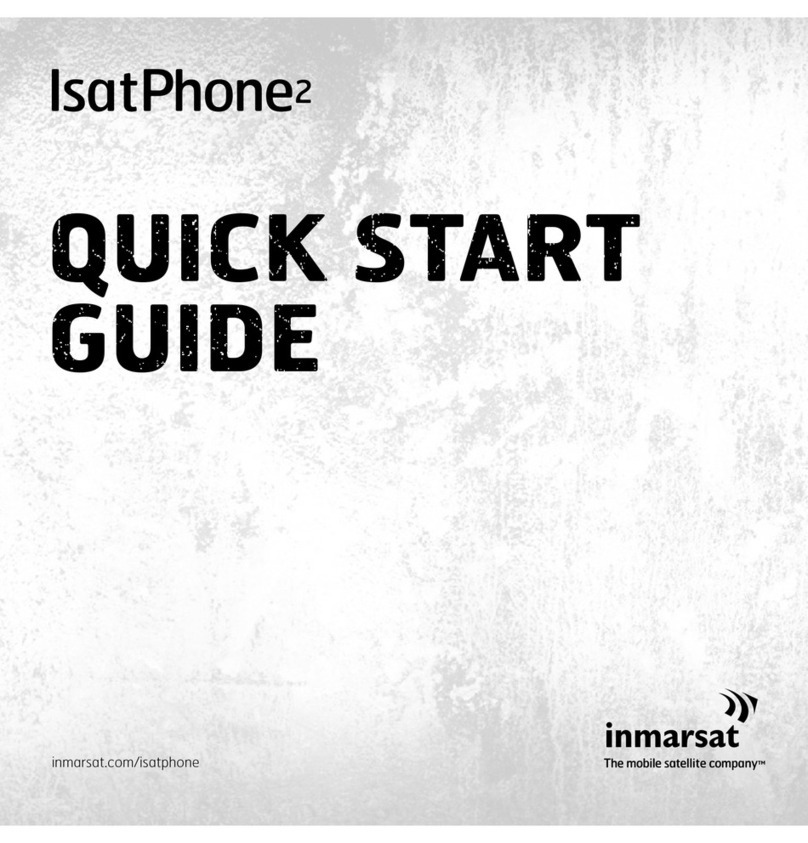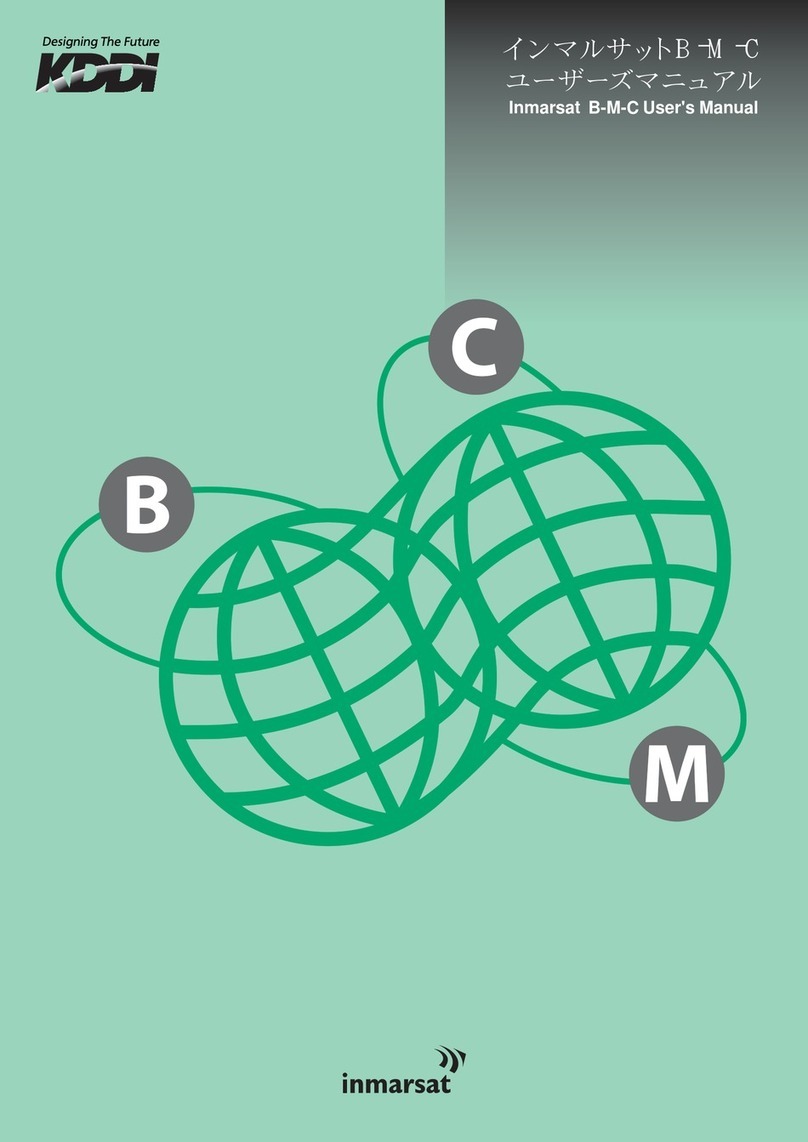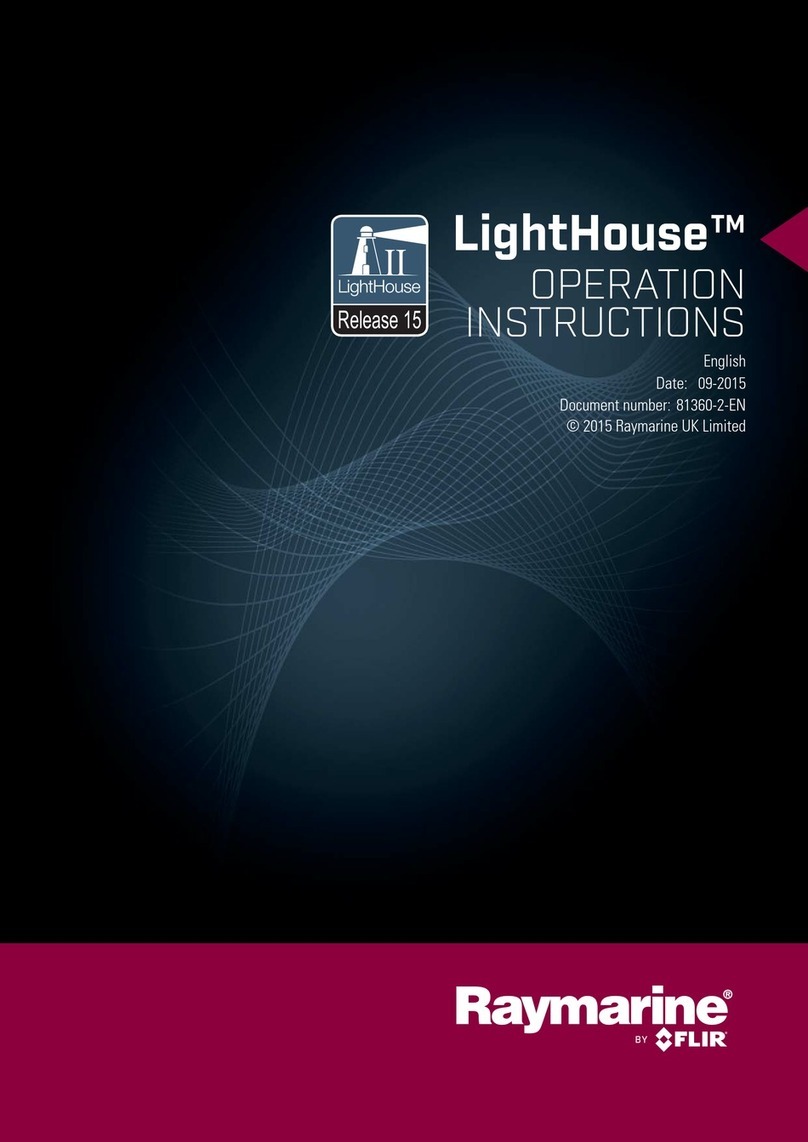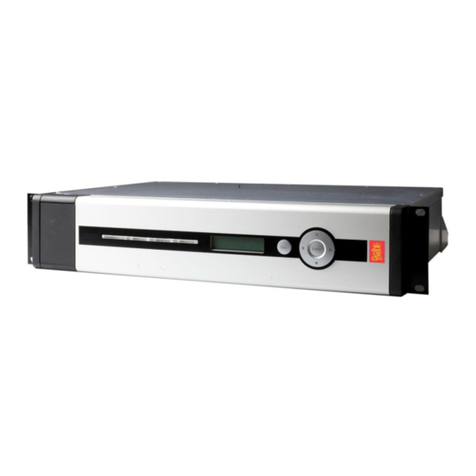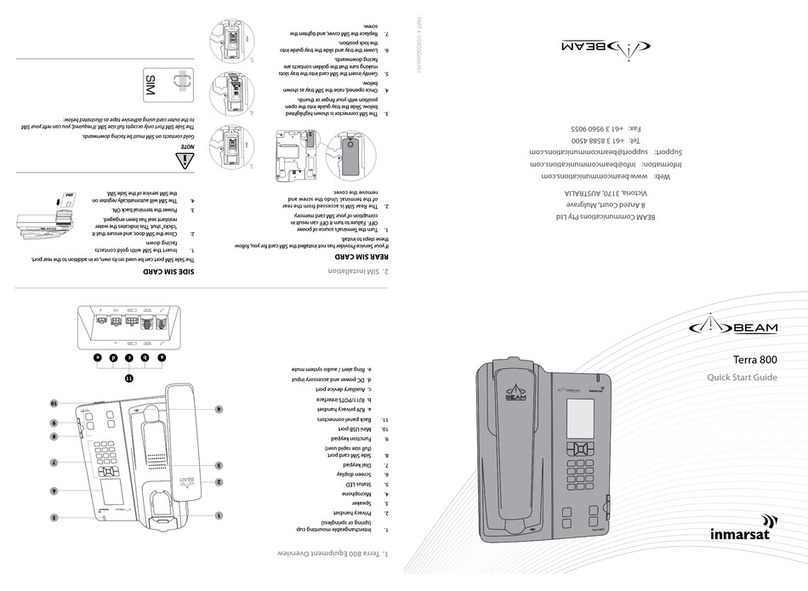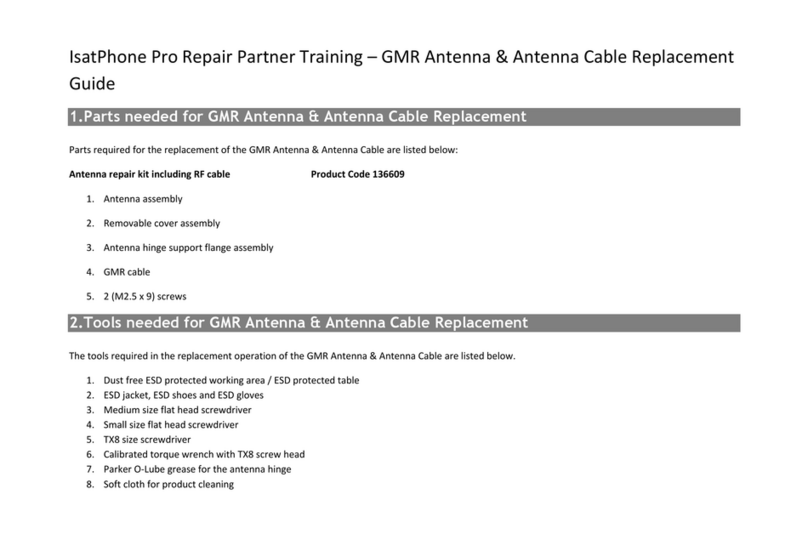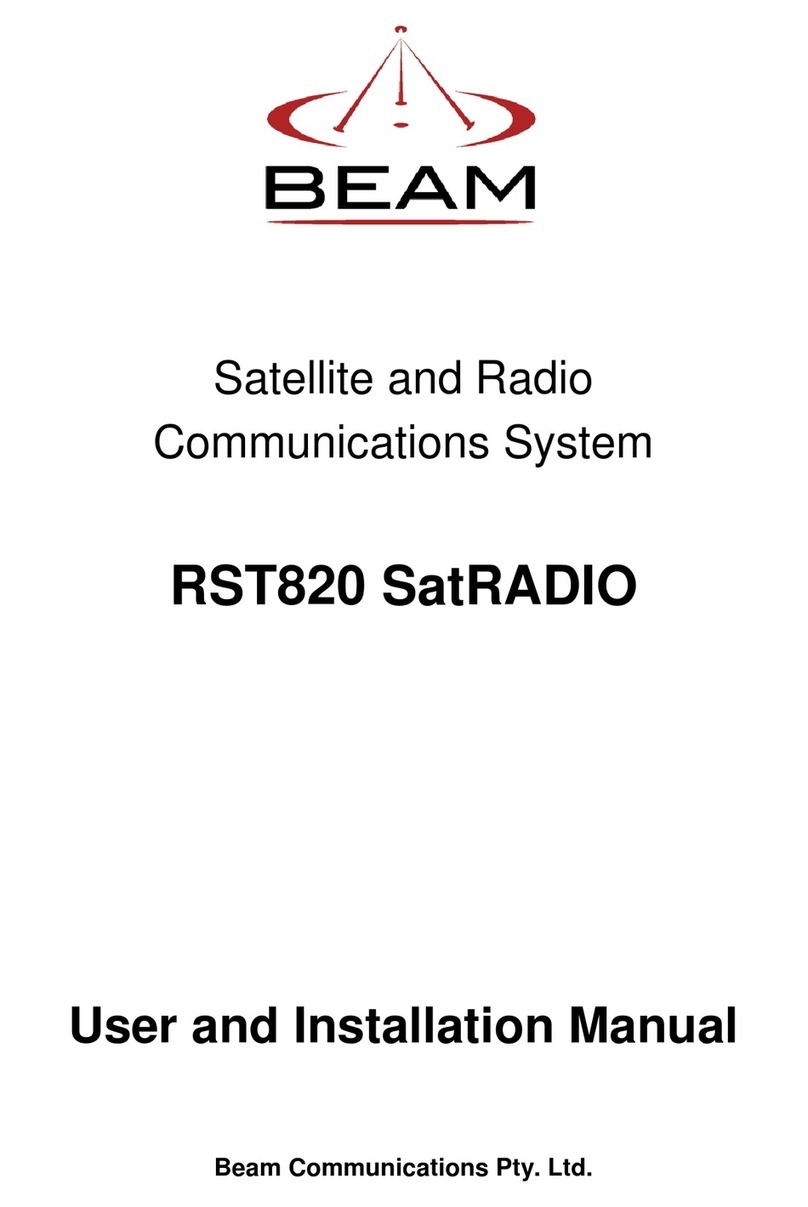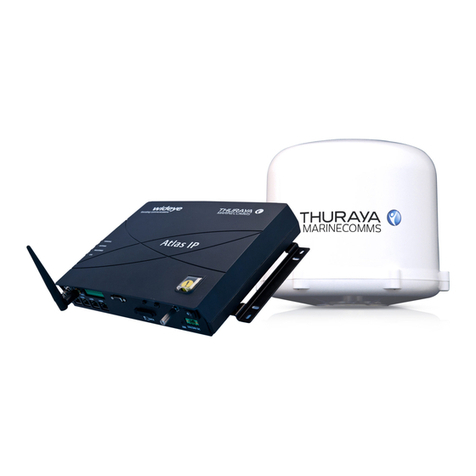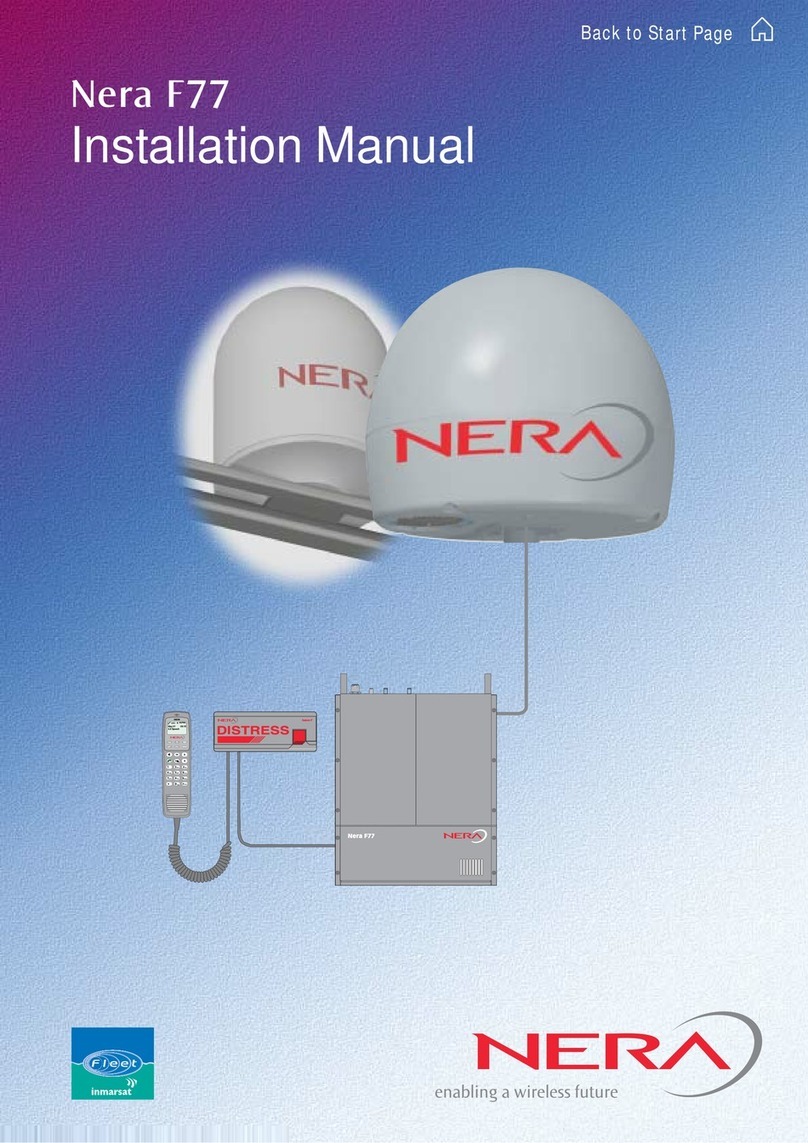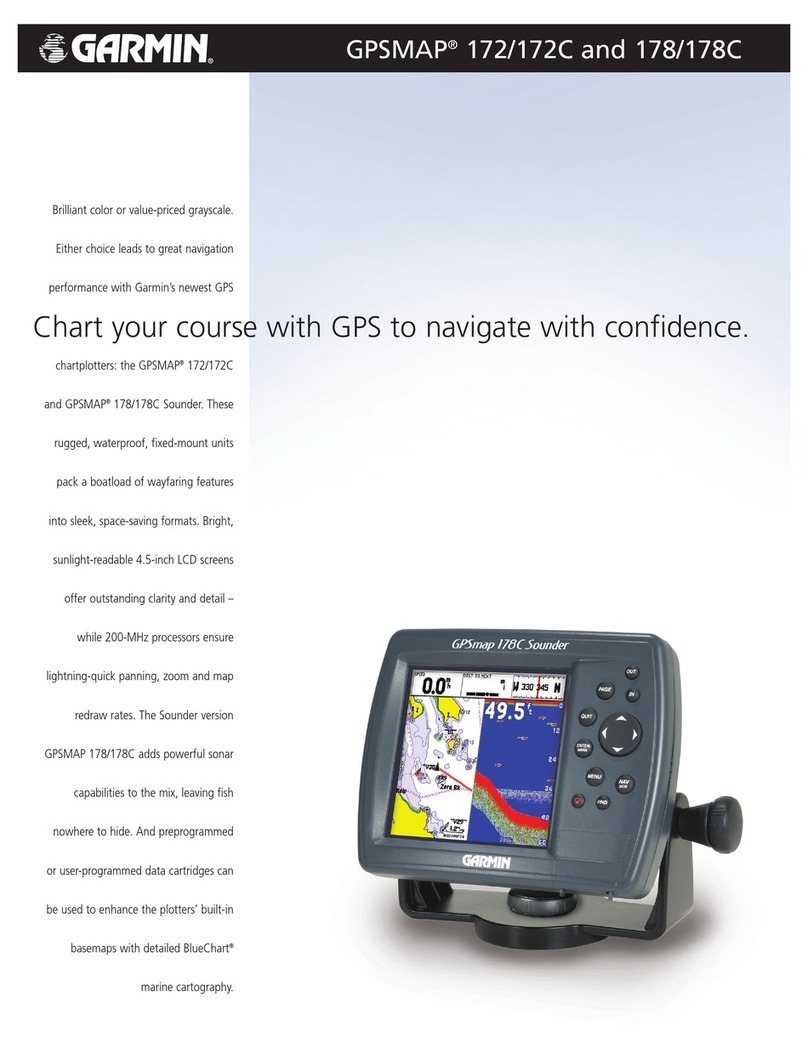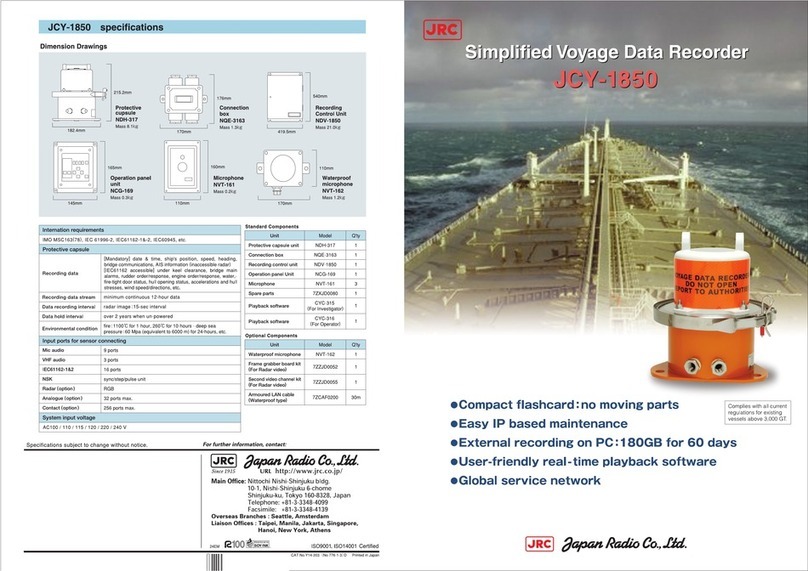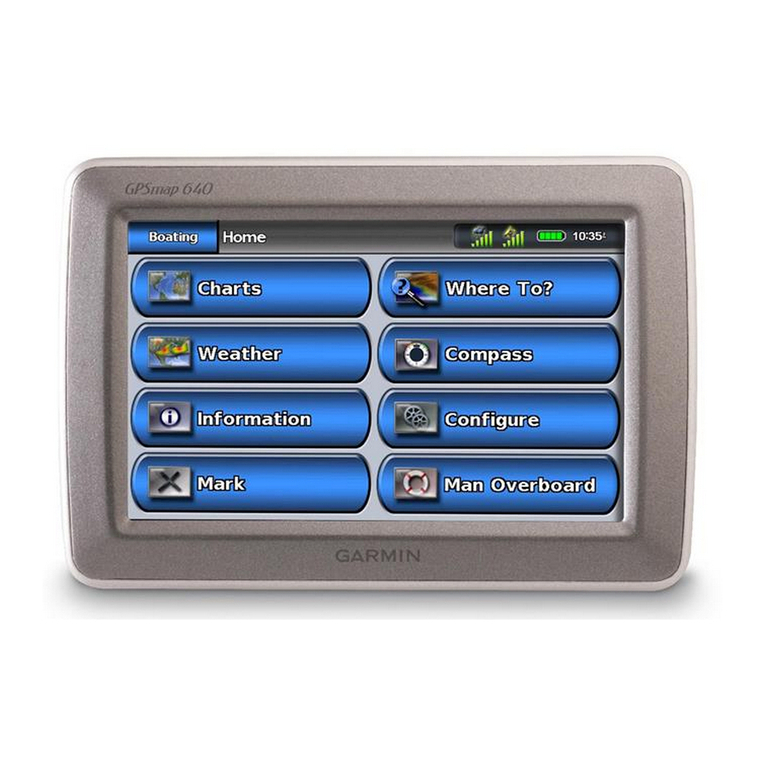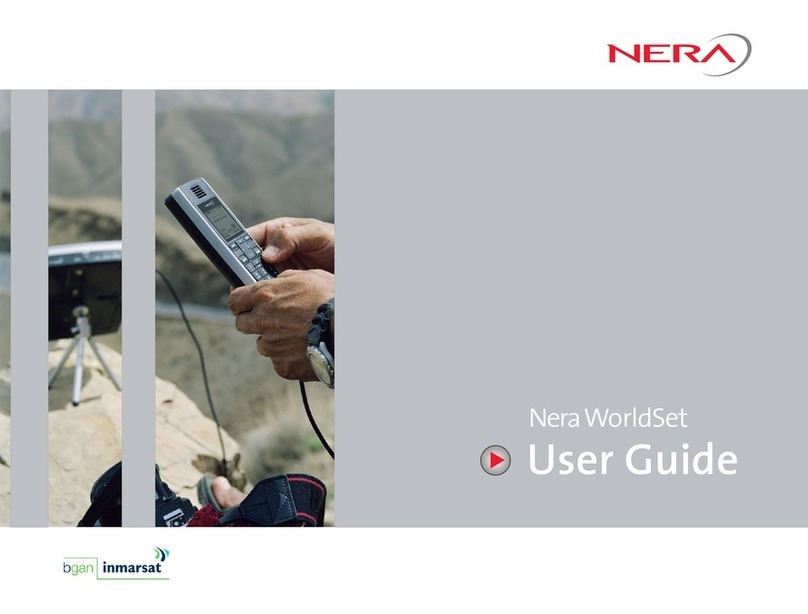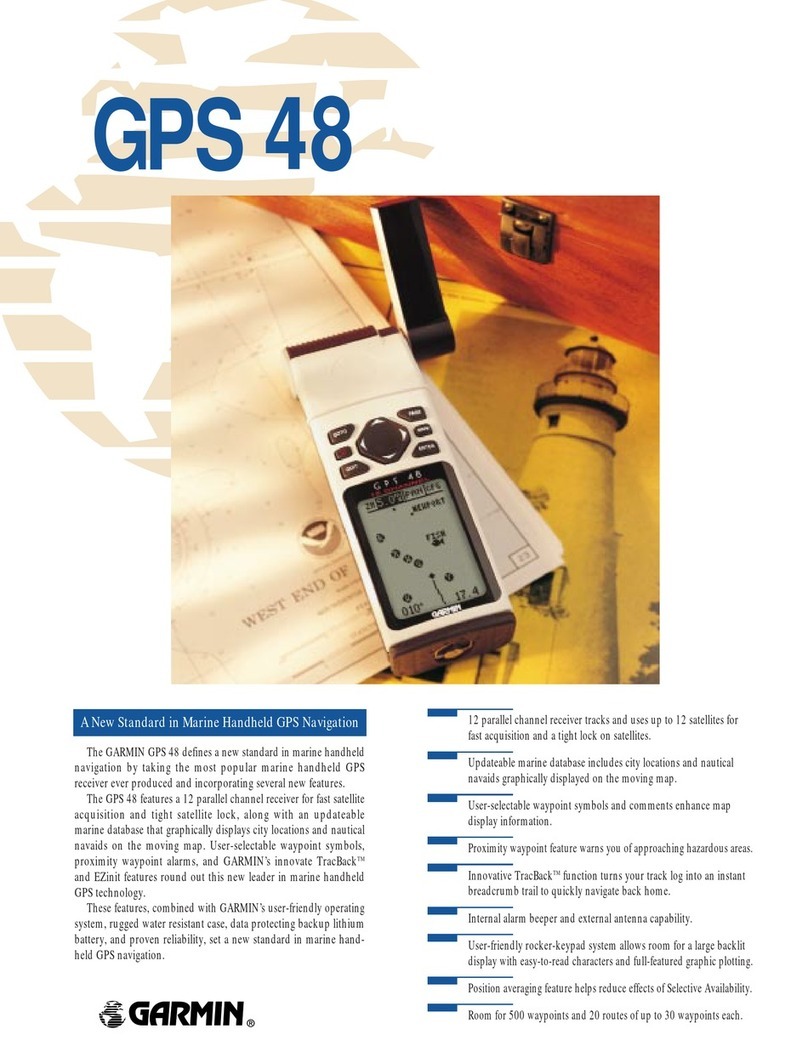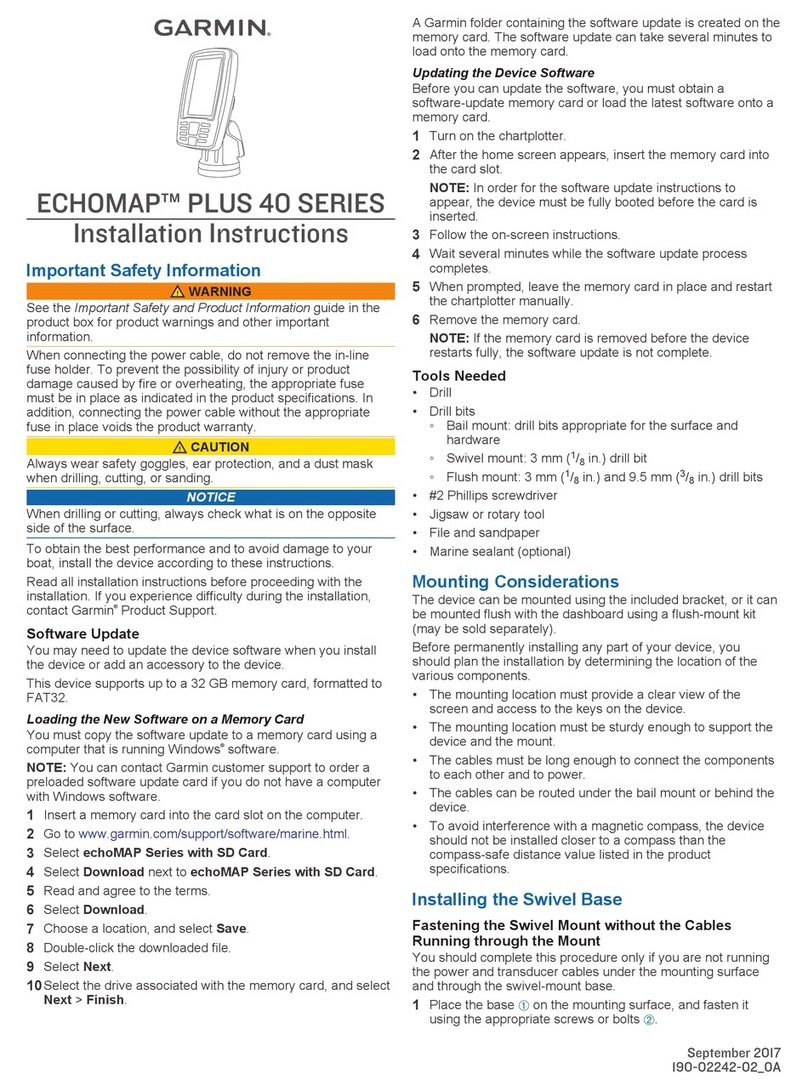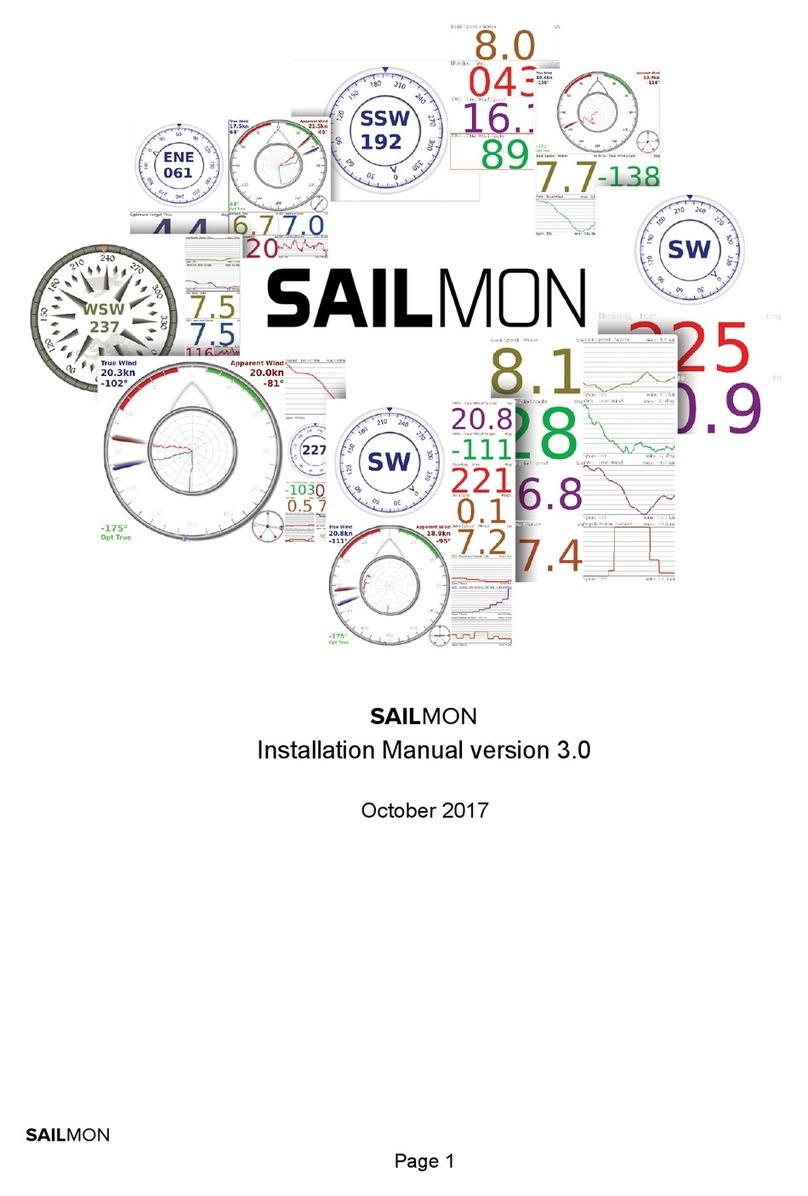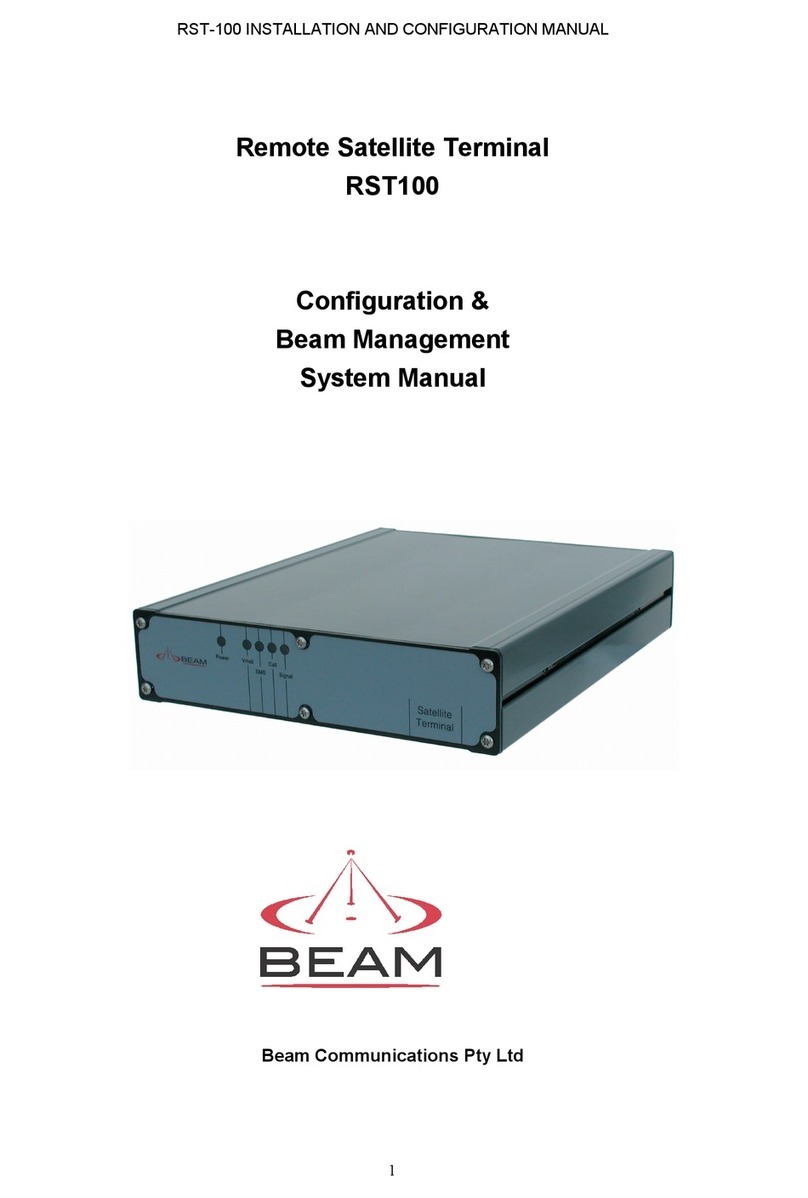Inmarsat wideye iFleetONE User manual

Satellite Terminal
Installation Manual
Revision 2.0

For assistance or additional information about this User Manual, please contact Customer
Care Support at:
Americas
Tel: +1 954 736 8829
Email: support@wideye.com.sg
Asia
Tel: +65 9820 1820
Email: support@wideye.com.sg
Whilst the above information has been prepared by Addvalue Innovation Pte Ltd (“Addvalue”)
in good faith, and all reasonable efforts have been made to ensure its accuracy, Addvalue
makes no warranty or representation as to the accuracy, completeness, or fitness for purpose
or use of the information. Addvalue shall not be liable for any loss or damage of any kind,
including indirect or consequential loss, arising from use of the information and all warranties
and conditions, whether express or implied by statute, common law or otherwise, are hereby
excluded to the extent permitted by the law of Singapore. Addvalue, the Addvalue Enabled
logo, Wideye, and the Wideye logo are either trademarks or registered trademarks of
Addvalue Technologies Ltd and/or its affiliates in Singapore and/or other countries.

Page 3 of 41
iFleetONE™Terminal Installation Manual
LIST OF CONTENT:
CERTIFICATION ____________________________________________________________5
SAFETY INSTRUCTIONS_____________________________________________________8
IMPORTANT INFORMATION TO INSTALLERS AND USERS _______________________10
INMARSAT FLEET ONE COVERAGE __________________________________________12
SYSTEM CONFIGURATION__________________________________________________13
USER EQUIPMENT LISTS ___________________________________________________14
iFleetONE™ USER EQUIPMENT______________________________________________15
1.1 Introduction _______________________________________________________15
1.2 Above Deck Equipment _____________________________________________15
1.3 Below Deck Equipment______________________________________________16
1.4 Optional Primary Handset with Cradle _________________________________16
INSTALLATION OF iFleetONE™ TERMINAL ____________________________________17
1.5 Installation of ADU _________________________________________________17
1.5.1 Overview ______________________________________________________17
1.5.2 Radiation Hazard ________________________________________________17
1.5.3 Interference ____________________________________________________18
1.5.4 Obstruction_____________________________________________________20
1.5.5 Antenna Mast ___________________________________________________21
1.5.6 Installing the Antenna Unit _________________________________________22
1.6 Installation of the BDU ______________________________________________23
1.7 Installation of the Optional Primary Handset ____________________________26
CONNECTIONS ___________________________________________________________27
1.8 BDU’s Output Connections __________________________________________28
1.8.1 GPS Output Connector ___________________________________________28
1.8.2 GPIO Port______________________________________________________29
1.8.3 Grounding Stud _________________________________________________30
GETTING STARTED ON THE SYSTEM ________________________________________30
1.9 Installing the SIM card ______________________________________________30
1.10 Powering up the system _____________________________________________32
1.10.1 Switching on the BDU ____________________________________________32
1.11 Settings on Web Console ____________________________________________33
1.11.1 Activating on Web Console ________________________________________33
1.11.2 Activating a PDP Context__________________________________________34
1.11.3 Deactivating a PDP Context________________________________________35
GLOSSARY_______________________________________________________________36

Page 4 of 41
iFleetONE™Terminal Installation Manual
APPENDIX A OUTLINE DRAWINGS ___________________________________________37
A-1 ADU - Outline Dimensions and Weight _________________________________37
A-2 ADU - Hole Pattern (Cut-out Holes) ____________________________________38
A-3 BDU - Outline Dimensions and Weight _________________________________39
A-4 Optional Primary Handset - Outline Dimensions _________________________39
APPENDIX B GPIO PORT ___________________________________________________40
B-1 Data Connection Switch _____________________________________________40

Page 5 of 41
iFleetONE™Terminal Installation Manual
CERTIFICATION
FEDERAL COMMUNICATION COMMISSION NOTICE
FCC Identifier: QO4-WEFLONEVTWO
USE CONDITIONS
This device complies with Part 15 of the FCC Rules. Operation is subject to the following two
conditions:
(1) This device may not cause harmful interference, and
(2) This device must accept any interference received, including interference that may
cause undesired operation.
NOTE
This equipment has been tested and found to comply with the limits for a Class B digital
device, pursuant to Part 15 of the FCC Rules. These limits are designed to provide reasonable
protection against harmful interference in a residential installation. This equipment generates
uses and can radiate radio frequency energy and, if not installed and used in accordance with
the instructions, may cause harmful interference to radio communications. However, there is
no guarantee that interference will not occur in a particular installation.
If this equipment does cause harmful interference to radio or television reception, which can
be determined by turning the equipment off and on, the user is encouraged to try to correct the
interference by one of the following measures:
· Reorient or relocate the receiving antenna.
· Increase the separation between the equipment and receiver.
· Connect the equipment into an outlet on a circuit different from that to which the
receiver is connected.
· Consult the dealer or an experienced radio/TV technician for help.
IMPORTANT NOTE: EXPOSURE TO RADIO FREQUENCY RADIATION
This device complies with FCC radiation exposure limits set forth for an uncontrolled
environment. The antenna used for this transmitter must be installed to provide a separation
distance of at least 1m from all persons and must not be co-located or operating in
conjunction with any other antenna or transmitter.

Page 6 of 41
iFleetONE™Terminal Installation Manual
FCC CAUTION:
Any changes or modifications not expressly approved by the manufacturer could void the
user’s authority, which is granted by FCC, to operate this iFleetONE™ Maritime Satellite
Terminal.
Industry Canada Statement:
IC: 5023B-WEFLONEVTWO
This device complies with Industry Canada’s license-exempt RSSs. Operation is subject to the
following two conditions:
(1) This device may not cause interference; and
(2) This device must accept any interference, including interference that may cause undesired
operation of the device.
Le présent appareil est conforme aux CNR d’Industrie Canada applicables aux appareils radio
exempts de licence. L’exploitation est autorisée aux deux conditions suivantes:
1) l’appareil ne doit pas produire de brouillage;
2) l’appareil doit accepter tout brouillage radioélectrique subi, même si le brouillage est
susceptible d’en compromettre le fonctionnement.

Page 7 of 41
iFleetONE™Terminal Installation Manual
CE RED Declaration of Conformity:
The CE RED Declaration of Conformity for the WideyeTM iFleetONE™ terminal will be added
on this page after completing the upgrade process of the CE RED tests.
Mobile Earth Stations (MES) 1668 –1670 MHz is under restricted usage under ECC Decision
ECC/DEC/ (04)09 for EU Countries. User/Operator shall check with local Radio Spectrum
regulator for necessary operating license and restriction usage and protection of Local Radio
service.
AT
BE
BG
CZ
DK
EE
FR
DE
IS
IE
IT
EL
ES
CY
LV
LI
LT
LU
HU
MT
NL
NO
PL
PT
RO
SI
SK
TR
FI
SE
CH
UK
HR

Page 8 of 41
iFleetONE™Terminal Installation Manual
SAFETY INSTRUCTIONS
For safety and protection, read the manual before attempting to use the iFleetONE™ User
Equipment (UE).
The following general safety precautions must be observed during all phases of operation,
service and repair of this equipment. Failure to comply with these precautions or with specific
warnings elsewhere in this user guide violates safety standards of intended use of the UE.
Addvalue Innovation Pte Ltd assumes no liability for the customer's failure to comply with
these requirements.
Hazard Symbols
Hot Surfaces
Avoid touching those areas of the UE that are marked
with this symbol otherwise it may result in injury.
Antenna Radiation Warning
and Distance to other
Radiation Equipment
For safety reasons, all personnel must keep at least
1 meter from the antenna.
Power Supply
Turn off the power at the mains switchboard before
beginning of the installation.
Confirm the power voltage is compatible with voltage
rating of the equipment. It is highly recommended to use
12V - 24V DC, 12.5A - 6.25A power line, provided that it
is available on the vessel.
If there is no suitable DC power line provided by the
vessel, an external AC/DC power supply (input range of
100~240V AC, 50~60Hz) with an output of +24V DC,
6.25A can be used.
Note: The requirements of the AC/DC power supply
should take care of high surge current of 25A at 24V
DC for 1ms.

Page 9 of 41
iFleetONE™Terminal Installation Manual
Grounding, cables and
connections
The chassis of the equipment must be connected to an
electrical ground. This will minimise electric shock and
mutual interference. In short, the UE must be grounded
to the vessel.
Service
Do not attempt to access to the interior of the equipment.
Only qualified personnel authorized by its manufacturer
may perform service. Failure to comply with this rule will
result in the warranty being voided.
Under certain conditions, dangerous voltages may exist
even with the power cable removed. To avoid injuries,
always disconnect power before accessing the
equipment.
Equipment Ventilation
To ensure adequate cooling of the terminal, 5 centimetres of unobstructed space must be
maintained around all sides of the unit except the bottom side. The operational temperature
range of the transceiver is: -25°C to +55°C.
Fire Precautions
The equipment shall not be operated in the presence of flammable gases or fumes as well as
any explosive atmosphere. Operation of any electrical equipment in such an environment
constitutes a definite safety hazard.
Obtaining Licensing For Inmarsat Transceivers
Under rights given under ITU Radio Regulations, local telecommunications administrations
establish and enforce national rules and regulations governing types of emissions, power
levels, and other parameters that affect the purity of signal, which may be radiated in the
various frequency bands of the radio spectrum.
To legally operate Inmarsat equipment, it is necessary to obtain permission from the local
telecommunications regulatory authorities of the country you are operating from. Using your
equipment in any country without permission causes you to run the risk of confiscation of the
equipment by the local authorities. The normal procedure to bring such equipment into another
country is to apply for a license before travel. If a license has not been obtained before travel,
the equipment may be put in to storage by local authorities until such time that a license is
obtained.

Page 10 of 41
iFleetONE™Terminal Installation Manual
IMPORTANT INFORMATION TO INSTALLERS AND USERS
General
It is important that the user of this equipment read and observe all safety requirements and
operate the terminal according to the descriptions published in this manual.
Failure to comply may result in risk of injury or equipment failure and voids the validity of the
warranty provided by the equipment manufacturer.
The terminal consists of 2 units; the BDU and the ADU. They must be used as provided by the
manufacturer or authorized dealer. Do not substitute any one part of the system which is not
provided by the manufacturer or authorized dealer. Should servicing or replacement be
required, always contact the distributor or manufacturer for instructions and assistance.
Any modifications or attempts to open the devices by non-authorized personnel will void the
warranty.
Contents in this manual are subjected to change without notice and may contain errors or
inaccuracies. The manual is periodically revised and updated. To obtain the latest version,
please enquire about it from the product manufacturer or distributor.
RF Specifications
Frequencies of Inmarsat I-4
Transmit: 1626.5 - 1660.6 MHz
Receive: 1525.0 - 1559.0 MHz
Frequencies of Inmarsat Alphasat
Transmit: 1668.0 - 1670.0 MHz
Receive: 1518.0 - 1559.0 MHz
Transmit EIRP: 15.1 dBW
Copyright
© Copyright 2017 Addvalue Innovation Pte Ltd.
All rights reserved. This publication and its contents are proprietary to Addvalue Innovation Pte
Ltd. No part of this publication may be reproduced in any form or by any means without the
written permission of Addvalue Innovation Pte Ltd.

Page 11 of 41
iFleetONE™Terminal Installation Manual
Warranty
Addvalue Innovation Pte Ltd. has made every effort to ensure the correctness and
completeness of the material in this document. Addvalue Innovation Pte Ltd shall not be liable
for errors contained herein. The information in this document is subject to change without
notice. Addvalue Innovation Pte Ltd. makes no warranty of any kind with regard to this
material, including, but not limited to, the implied warranties of merchantability and fitness for a
particular purpose.
Trademarks
All trademarks, marks, names, or product names referenced in this publication are the
property of their respective owners, and Addvalue Innovation Pte Ltd neither endorses nor
otherwise sponsors any such products or services referred to herein.
Microsoft, Windows, Windows NT, Windows 2000, Windows XP and Windows 7 are registered
trademarks of Microsoft Corporation in the U.S.A. and/or other countries.
All other company and product names may be the registered trademarks or trademarks of their
respective owners.

Page 12 of 41
iFleetONE™Terminal Installation Manual
INMARSAT FLEET ONE COVERAGE
Fleet One is Inmarsat’s global service and its specific tariff is only available in those green
areas of the coverage map (see below).
For updated information on coverage, refer to Inmarsat website (www.inmarsat.com).
The green areas represent the voice and data services and they are known as the “Home
Region” area. The area outside the home region area is known as” Out of Region” which
supports only voice service (including 505 emergency call). Roaming outside the Out of
Region area will have an impact on the airtime price. A buyer is advised to consult Inmarsat
Airtime Providers for specific information regards to airtime prices and specific coverage.
Only Inmarsat Fleet One SIM card can be used with an iFleetONE™ terminal.

Page 13 of 41
iFleetONE™Terminal Installation Manual
SYSTEM CONFIGURATION
Solid line refers to the basic configuration.
iFleetONE™ ADU
iFleetONE™
BDU
Router / Computer
External Devices
Above Deck Unit
(To be installed in an exposed area)
Below Deck Unit
(To be installed in protected area)
AC/DC Power
Supply Unit
RJ45
GPIO Interface
Navigation
Equipment
GPS O/P (NMEA 0183)
Wi-Fi
RS232 Serial
Analog Phone
15-m Antenna Cable
+12V / +24V DC
RJ11
Primary Handset

Page 14 of 41
iFleetONE™Terminal Installation Manual
USER EQUIPMENT LISTS
iFleetONE™ Complete Standard Package
Description
Order Code
Wideye iFleetONE™ BDU
FLV2-9TB00-01
Wideye iFleetONE™ ADU with 15-meter Antenna Cable
FLV2-0AN00-01
iFleetONE™ Optional Accessories
Description
Order Code
Wideye iFleetONE™ Primary Handset
SLF1-0PH00-01
Power Supply 240W AC/DC DIN Rail 24V DC/10A
SKP150/ADPS
Antenna Coaxial Cable N(M) to N(M) (25m)
FX50-0CA25-01
Antenna Coaxial Cable N(M) to N(M) (35m)
FX50-0CA35-01
Antenna Coaxial Cable N(M) to N(M) (50m)
FX50-0CA50-01
Antenna Pole Mount with Mounting Kit
FX25-0PM00-01

Page 15 of 41
iFleetONE™Terminal Installation Manual
iFleetONE™ USER EQUIPMENT
1.1 Introduction
The iFleetONE™ user equipment (UE) consists of two units:
Below Deck Equipment (BDU) which is a communication unit
Above Deck Equipment (ADU) which is an antenna unit
The wired Primary Handset with a cradle is an optional accessory.
1.2 Above Deck Equipment
The ADU is a 3-axis controlled antenna unit which is self-tracking.
The radome covers the antenna unit, which is comprised of
Antenna Module
RF and GPS Module
Rotary Joint
Antenna Pedestal
The antenna module includes a low noise amplifier (LNA), high power amplifier (HPA), and
tracking receiver circuitry. All the signals and power pass through a single coaxial antenna
cable, which connects the ADU to the BDU.

Page 16 of 41
iFleetONE™Terminal Installation Manual
1.3 Below Deck Equipment
The BDU is the heart unit of the iFleetONE™ UE. It has several interface ports and handles all
communication links between the ADU, optional Primary Handset and the local communication
devices such as analog telephone, computer, network equipment, navigation equipment etc.
The BDU requires +12V or +24V DC power supply input. It supplies power to the ADU via a
single RF / coaxial antenna cable.
1.4 Optional Primary Handset with Cradle
The wired Primary Handset has a colour liquid crystal display (LCD) and keypad for making
and receiving normal voice calls and sending SMS, similar to any mobile phone. The handset
is provided with a cradle.
Additionally, it can be served as a remote access device for a user to access various
configuration parameters supported by the BDU.
The Primary Handset’s connector is plugged into the BDU’s primary handset port. It is
powered directly from the BDU.

Page 17 of 41
iFleetONE™Terminal Installation Manual
INSTALLATION OF iFleetONE™ TERMINAL
1.5 Installation of ADU
1.5.1 Overview
In general, any obstructing objects like a mast near the antenna unit can block reception or
transmission from the satellite’s line of sight. In addition, RF radiation emitting from the
antenna will affect the human body. When selecting a mounting location, it is important to
ensure that the antenna unit shall be free of severe vibration and shock and heat and smoke
from the funnel. More guidelines will be detailed in the next sections.
1.5.2 Radiation Hazard
Radio waves can pose a hazard to the human body. Safe distances are subject to country
and ship construction regulations. There is no standard formula to calculate the safe
distance. The below guidelines are to be noted.
iFleetONE™ ADU
WARNING: Keep away from the antenna radome at the mentioned
safe distance when it is transmitting. Microwave radiation can be
harmful to human body, particularly the eyes.
MICROWAVE RADIATION!
NO ADMITTANCE WITHIN SAFETY
DISTANCE
SAFETY DISTANCE
1m
ANTENNA
UNIT

Page 18 of 41
iFleetONE™Terminal Installation Manual
1.5.3 Interference
The antenna unit must be mounted as far as possible away from the HF antennas,
communication/navigations, VSAT systems and any high power radio transmitter (including
other Inmarsat-based systems).
Radar
It is difficult to provide the exact minimum distance between a radar and the antenna
unit due to different type of radars in terms of power, radiation pattern and operating
frequency band.
The antenna unit is recommended to be at least ±15⁰from the radar’s vertical beam.
The minimum radar distance indicates the minimum distance between the closest
point of the radar and the closest surface of the antenna radome. This distance is
determined by the radar, transmit frequency and the power.
Minimum Distance, d
+15º (Min)
-15º (Min)
Antenna
Unit
Antenna
Unit

Page 19 of 41
iFleetONE™Terminal Installation Manual
The table below gives the recommended minimum distance d between X- and S-
band radars and the antenna. Antenna damage is normally avoided by ensuring the
separation distance is met or exceeded.
Antenna location at the minimum distance from Radar (S-Band)
Radar
Power
Min distance (d) at ±15⁰vertical
separation
min distance (d) at ±60⁰vertical
separation
0 - 12 kW
0.5 m
0.3 m
30 kW
1.0 m
0.5 m
50 kW
2.0 m
1.0 m
Antenna location at the minimum distance from Radar (X-Band)
Radar
Power
min distance (d) at ±15⁰vertical
separation
min distance (d) at ±60⁰vertical
separation
0 - 12 kW
0.9 m
0.5 m
30 kW
2.4 m
1.2 m
50 kW
4.0 m
2.0 m
Transmitting Equipment < 1GHz
HF and VHF transmitters can also interfere with the performance of the antenna and
also damage the antenna if placed too close. The table below gives guidelines for the
minimum distance between the antenna and HF and VHF transmitters.
Antenna location at the minimum distance from HF / VHF
Type
Power
Distance
HF < 60MHz
100 W
1.0 m
HF < 60 MHz
500 W
2.5 m
VHF > 60 MHz
25 W
1.5 m
VSAT System
For optimum performance the distance between the antenna and VSAT antennas
should be at least 3 meters.
GPS Antenna
As the antenna transmits power close to the GPS receive band, the minimum
distance to GPS antennas is typically 5 meters.
Other L-Band Systems
Typical L-Band satellite communication equipment should be able to operate in close
proximity without loss of performance (Refer to Section 2.1.4 Distance to obstruction
objects). Importantly such equipment typically includes GPS antennas, and that it can
be necessary to use the typical minimum separation distance of typically 5 meters.

Page 20 of 41
iFleetONE™Terminal Installation Manual
1.5.4 Obstruction
When locating the antenna, it is very important to ensure that there is a clear line-of-sight to
the satellite for all the satellite elevation angles in the region in which the vessel will operate.
The antenna moves in azimuth 360⁰and in roll and pitch down to -15⁰to ensure constant
tracking even in heavy seas. Any obstructions within this arc can cause performance
degradation of the signal quality. The amount of degradation depends on the size of the
obstruction and distance from the antenna. The table below is a guide on the object size, at a
given distance from the antenna that gives limited degradation.
Object Distance
Object Size
3 m
16 cm
6 m
32 cm
10 m
52 cm
15 m
79 cm
Table of contents
Other Inmarsat Marine GPS System manuals
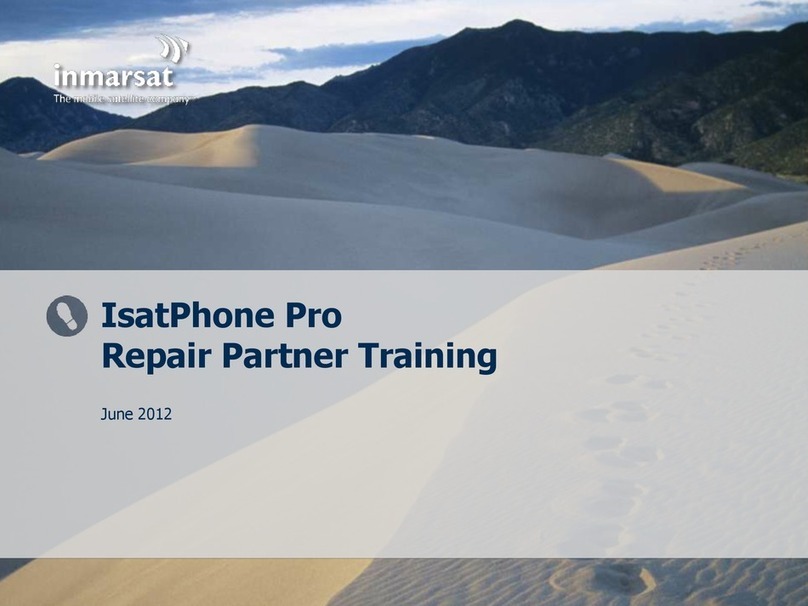
Inmarsat
Inmarsat IsatPhone Pro Installation guide
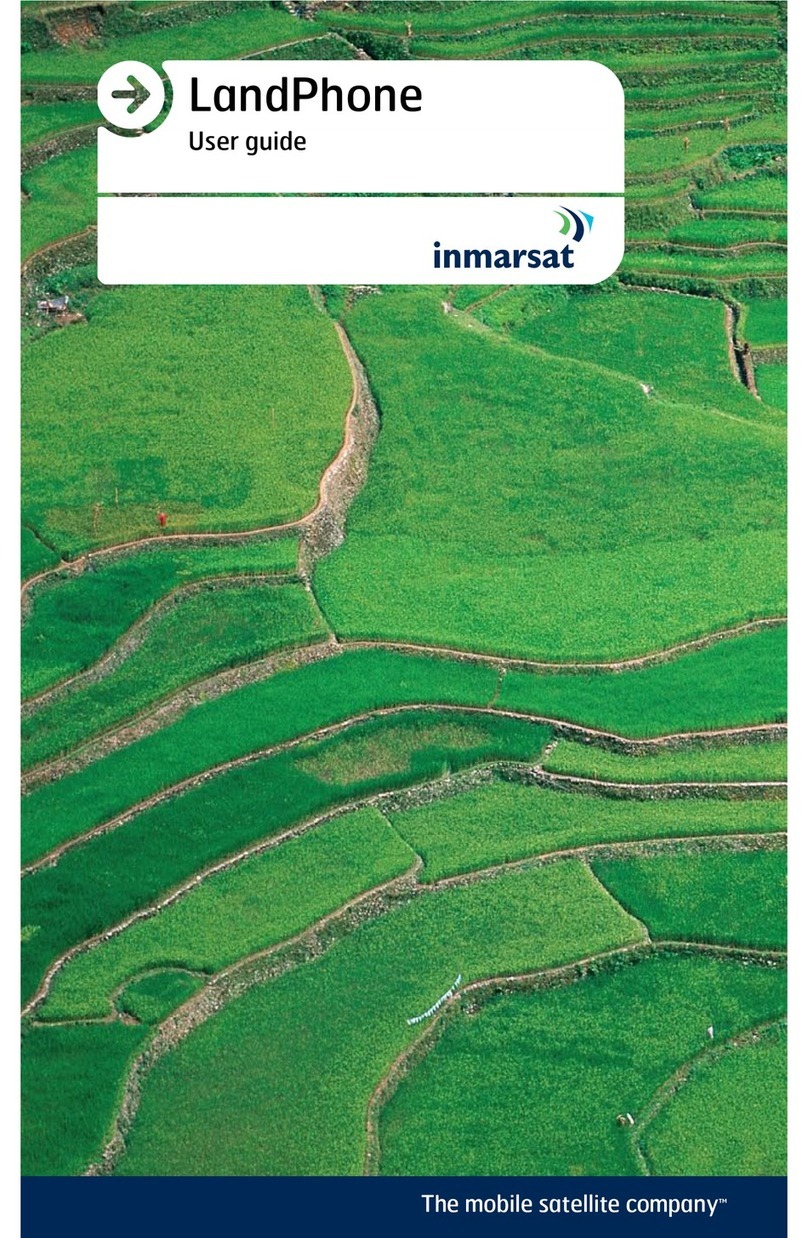
Inmarsat
Inmarsat LandPhone User manual
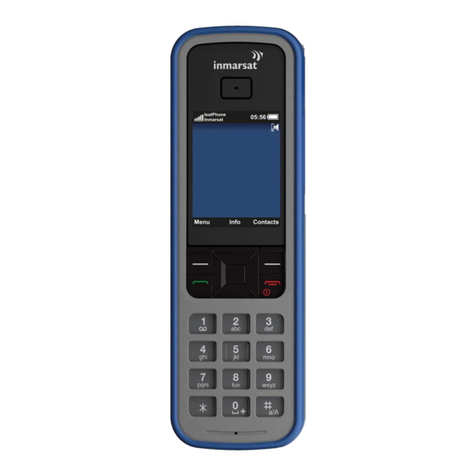
Inmarsat
Inmarsat IsatPhone Pro User manual

Inmarsat
Inmarsat LandPhone User manual
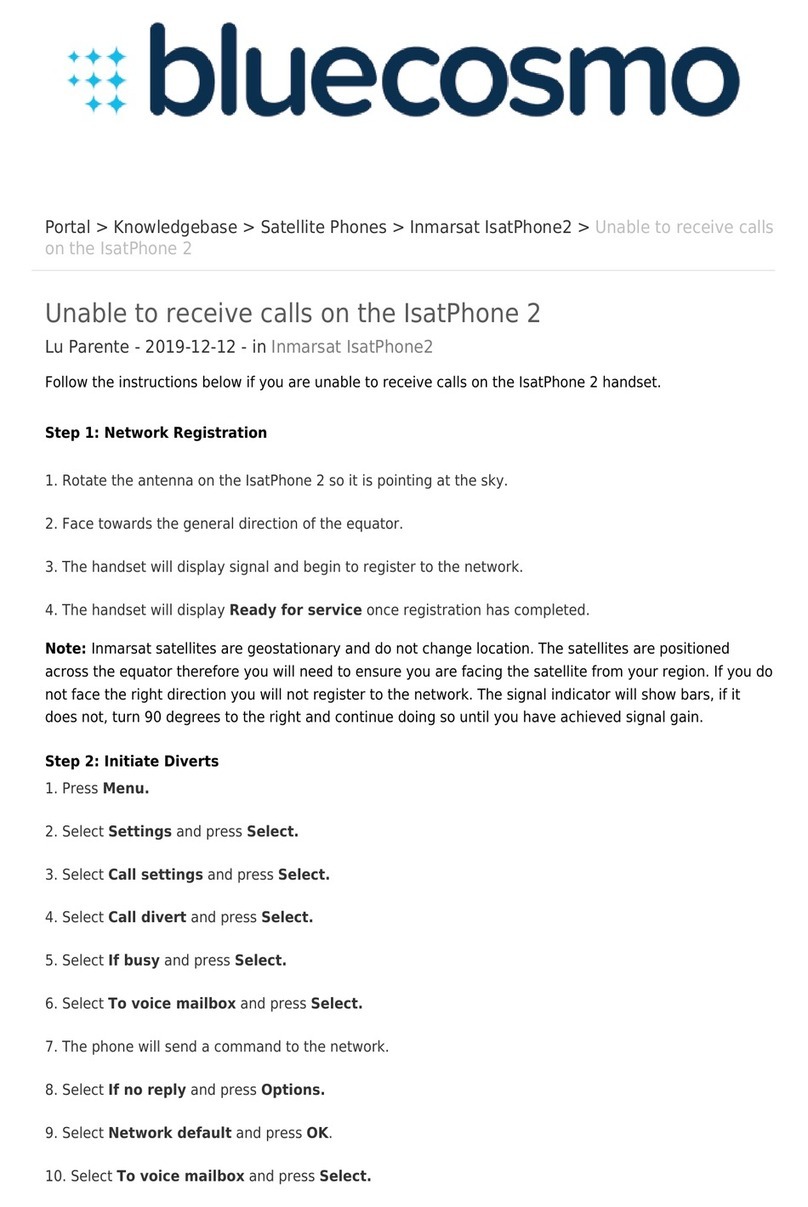
Inmarsat
Inmarsat IsatPhone 2 User manual

Inmarsat
Inmarsat IsatPhone Pro Installation guide
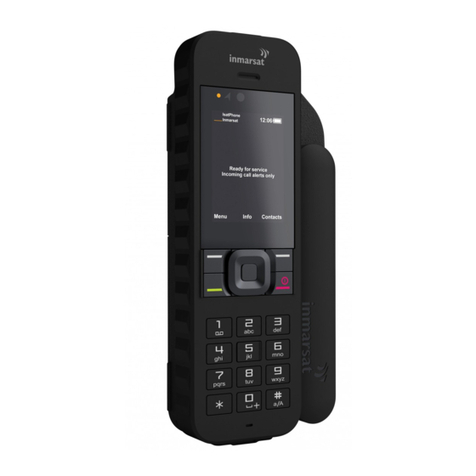
Inmarsat
Inmarsat IsatPhone 2 Operating manual

Inmarsat
Inmarsat IsatPhone 2 Assembly instructions

Inmarsat
Inmarsat IsatPhone 2 User manual

Inmarsat
Inmarsat IsatPhone 2 User manual
